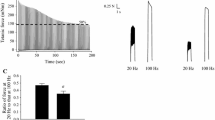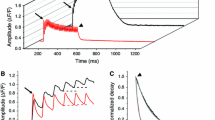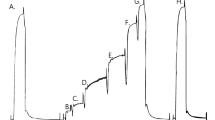Abstract
This review attempts to give an insight into the key aspects of excitation–contraction (E–C) coupling and fatigue in skeletal muscle, in particular summarizing the results and perspectives obtained from studies with mechanically skinned muscle fibres. These skinned fibre studies have provided many novel insights, such as the role of intracellular Mg2+ and ATP in the coupling mechanism, as well as how the accumulation of metabolic products, precipitation of inorganic phosphate in the sarcoplasmic reticulum (SR) and disruption of the coupling mechanism by high intracellular [Ca2+], may contribute to different types of muscle fatigue. The recent demonstration of action potential (AP)-induced Ca2+ release in skinned fibres [G.S. Posterino et al. (2000) J Physiol 527: 131–137] showed unequivocally that the normal E–C coupling mechanism [W. Melzer et al. (1995) Biochim Biophys Acta 1241: 59–116] was retained in this preparation and indicated the considerable potential of this technique. Among other things, it has been possible to show that AP activation of the voltage-sensors in the transverse-tubular (T-) system is normally sufficient to give maximal activation of the Ca2+ release channels (ryanodine receptors) in the SR and that increasing the sensitivity of the release channels to Ca2+, such as by oxidation or other means, does not increase the amount of Ca2+ released by an AP. In contrast, when the voltage-sensors are not fully activated, modulating the responsiveness of the Ca2+ release channels does affect the amount of Ca2+ release. It is suggested that some forms of muscle fatigue are caused by inadequate activation of the Ca2+ release channels due both to (a) inactivation or dysfunction of the voltage-sensors and (b) inhibitory effects on the release channels caused by local changes in the cytoplasmic environment (in particular by low [ATP] and raised concentrations of Mg2+, ATP metabolites and other factors) and by a decrease in the pool of releasable Ca2+ within the SR.
Similar content being viewed by others
References
Allen DG and Westerblad H (2001) Role of phosphate and calcium stores in muscle fatigue. J Physiol 536: 657–665.
Allen DG, Lännergren J and Westerblad H (1995) Muscle cell function during prolonged activity: cellular mechanisms of fatigue. Exp Physiol 80: 497–527.
Allen DG, Lännergren J and Westerblad H (2002) Intracellular ATP measured with luciferin/luciferase in isolated single mouse skeletal muscle fibres. Pflügers Arch 443: 836–842.
Andrade FH, Reid MB, Allen DG and Westerblad H (1998) Effect of hydrogen peroxide and dithiothreitol on contractile function of single skeletal muscle fibres from the mouse. J Physiol 509: 565–575.
Balog EM and Fitts RH (2001) Effects of depolarisation and low intercellular pH on charge movement currents of frog skeletal muscle fibres. J Appl Physiol 90: 228–234.
Balshaw DM, Yamaguchi N and Meissner G (2002) Modulation of intracellular calcium-release channels by calmodulin. J Membr Biol 185: 1–8.
Baylor SM, Chandler WK and Marshal MW (1983) Sarcoplasmic reticulum calcium release in intact frog skeletal muscle fibres estimated from Arsenazo III calcium transients. J Physiol 344: 625–666.
Beard NA, Sakowska MM, Dulhunty AF and Laver DR (2002) Calsequestrin is an inhibitor of skeletal muscle ryanodine receptor calcium release. Biophys J 82: 310–320.
Blazev R and Lamb GD (1999a) Low [ATP] and elevated [Mg2+] reduce depolarization-induced Ca2+ release in rat skinned skeletal muscle fibres. J Physiol 520: 203–215.
Blazev R and Lamb GD (1999b) Adenosine inhibits depolarization-induced Ca2+ release in mammalian skeletal muscle. Muscle and Nerve 22: 1674–1683.
Bruton JD, Scentes P, Lännergren J, Westerblad H Kovàcs L and Csernoch L (2000) Frog skeletal muscle fibers recovering from fatigue have reduced charge movement. J Muscle Res Cell Motil 21: 621–628.
Caputo C, Bolanos C and Gonzalez A (1993) Effects of sulfhydryl inhibitors on depolarizations-contraction coupling in frog skeletal muscle fibers. J Gen Physiol 101: 411–424.
Coonan JR and Lamb GD (1998) Effect of chloride on Ca2+ release from the sarcoplasmic reticulum of mechanically skinned skeletal muscle fibres. Pflügers Arch 435: 720–730.
Donoso P, Aracena P and Hidalgo C (2000) Sulfhydryl oxidation overrides Mg2+ inhibition of calcium-induced calcium release in skeletal muscle triads. Biophys J 79: 279–286.
Duke AM and Steele DS (1998) Effects of caffeine and adenine nucleotides on Ca2+ release by the sarcoplasmic reticulum in saponinpermeabilized frog skeletal muscle fibres. J Physiol 513: 43–53.
Dulhunty AF (1992) The voltage-activation of contraction in skeletal muscle. Prog Biophys Molec Biol 57: 181–223.
Dutka TL and Lamb GD (2000) Effect of lactate on depolarizationinduced Ca2+ release in mechanically skinned skeletal muscle fibers. Am J Physiol Cell Physiol 278: C517-C525.
Dutka TL and Lamb GD (2001) Effect of low [ATP] on actionpotential mediated Ca2+ release in fast-twitch muscle fibres. XXXIV International Congress of Physiological Sciences poster 665 http://iups.esc.auckland.ac.nz/abstracts/pdfs/iabs-omi-057–20 01–18–37–09.pdf.
Endo M (1985) Calcium release from sarcoplasmic reticulum. Curr Top Membr Transp 25: 181–230.
Favero TG, Zable AC and Abramson JJ (1995) Hydrogen peroxide stimulates the Ca2+ release channel from skeletal muscle sarcoplasmic reticulum. J Biol Chem 270: 25557–25563.
Favero TG, Zable AC, Colter D and Abramson JJ (1997) Lactate inhibits Ca2+ activated Ca2+ channel activity from skeletal muscle sarcoplasmic reticulum. J Appl Physiol 82: 447–452.
Fitts RH (1994) Cellular mechanisms of muscle fatigue. Physiol Rev 74: 49–94.
Franzini-Armstrong C and Jorgenson AO (1994) Structure and development of E-C coupling units in skeletal muscle. Ann Rev Pyhsiol 56: 509–534.
Fryer MW and Stephenson DG (1996) Total and sarcoplasmic reticulum calcium contents of skinned fibres from rat skeletal muscle. J Physiol 493: 357–370.
Fryer MW, Owen VJ, Lamb GD and Stephenson DG (1995) Effects of creatine phosphate and Pi on Ca2+ movements and tension development in reticulum calcium skinned skeletal muscle fibres. J Physiol 482: 123–140.
Fryer MW, West JM and Stephenson DG (1997) Phosphate transport into the sarcoplasmic reticulum of the skinned fibres from rat skeletal muscle. J Muscle Res Cell Motil 18: 161–167.
Gyorke S (1993) Effects of repeated tetanic stimulation on excitation-contraction coupling in cut muscle fibres of the frog. J Physiol 464: 699–710.
Hollingworth S, Zhao M and Baylor SM (1996) The amplitude and time course of the myoplasmic free [Ca2+] transient in fast-twitch fibers of mouse muscle. J Gen Physiol 108: 455–469.
Jona I, Szegedi C, Sarkozi S, Szentesi P, Csernoch L and Kovacs L (2001) Altered inhibition of the rat skeletal ryanodine receptor/calcium release channel by magnesium in the presence of ATP. Pflügers Arch 441: 729–738.
Karatzaferi C, de Haan A, Ferguson RA, van Mechelen W and Sargeant AJ (2001) Phosphocreatine and ATP content in human single muscle fibres before and after maximum dynamic exercise. Pflügers Arch 442: 467–474.
Lamb GD (1993) Ca2+-inactivation, Mg2+-inhibition and malignant hyperthermia. J Muscle Res Cell Motil 14: 554–556.
Lamb GD (2000) Excitation-contraction coupling in skeletal muscle: comparisons with cardiac muscle. Clin Exp Pharmacol Physiol 27: 216–224.
Lamb GD (2002) Voltage-sensor control of Ca2+ release in skeletal muscle: insights from skinned fibers. Front Biosci 7: d834–42. http://www.bioscience.org/2002/v7/d/lamb/list.htm.
Lamb GD and Cellini MA (1999) High intracellular [Ca2+] alters sarcoplasmic function in skinned skeletal muscle fibres of the rat. J Physiol 519: 815–827.
Lamb GD and Stephenson DG (1990) Control of calcium release and the effect of ryanodine in skinned muscle fibres of the toad. J Physiol 423: 519–542.
Lamb GD and Stephenson DG (1991) Effect of Mg2+ on the control of Ca2+ release in skeletal muscle fibres of the toad. J Physiol 434: 507–528.
Lamb GD and Stephenson DG (1992) Importance of Mg2+ in excitation-contraction coupling in skeletal muscle. News Physiol Sci 7: 270–274.
Lamb GD and Stephenson DG (1994) Effects of intracellular pH and [Mg2+] on excitation-contraction coupling in skeletal muscle fibres of the rat. J Physiol 478: 331–339.
Lamb GD, Cellini MA and Stephenson DG (2001a) Different Ca2+ releasing action of caffeine and depolarisation in skeletal muscle fibres of the rat. J Physiol 531: 715–728.
Lamb GD, Junankar PR and Stephenson GD (1995) Raised intracellular [Ca2+] abolishes excitation-contraction coupling in skeletal muscle of rat and toad. J Physiol 489: 349–362.
Lamb GD, Recupero E and Stephenson DG (1992) Effect of myoplasmic pH on excitation-contraction coupling in skeletal muscle fibres of the toad. J Physiol 448: 211–224.
Lamb GD, Posterino GS, Yamamoto T and Ikemoto N (2001b) Effects of a domain peptide of the ryanodine receptor on Ca2+ release in skinned skeletal muscle fibres. Am J Physiol Cell Physiol 281: C207-C214.
Lännergren J, Bruton JD and Westerblad H (2000) Vacuole formation in fatigued skeletal muscle fibres from frog and mouse: effects of extracellular lactate. J Physiol 526: 597–611.
Laver DR, Baynes TM and Dulhunty AF (1997) Magnesium-inhibition of ryanodine-receptor calcium channels: evidence for two independent mechanisms. J Membr Biol 156: 213–229.
Laver DR, Eager KR, Taoube L and Lamb GD (2000) Effects of cytoplasmic and luminal pH on Ca2+ release from rabbit skeletal muscle. Biophys J 78: 1835–1851.
Laver DR, Lenz GKE and Lamb GD (2001) Regulation of the calcium release channel from rabbit skeletal muscle by the nucleotides ATP, AMP, IMP and adenosine. J Physiol 537: 763–778.
Launikonis BS and Stephenson DG (1997) Effect of saponin treatment on the sarcoplasmic reticulum of rat, cane toad and crustacean (yabby) skeletal muscle. J Physiol 504: 425–437.
Launikonis BS and Stephenson DG (2001) Effects of membrane cholesterol manipulation on excitation-contraction coupling in skeletal muscle of the toad. J Physiol 534: 71–85.
Marx SO, Ondrias K and Marks AR (1998) Coupled gating between individual skeletal muscle Ca2+ release channels (ryanodine receptors). Science 281: 818–821.
Meissner G, Darling E and Eveleth J (1986) Kinetics of rapid Ca2+ release by sarcoplasmic reticulum. Effects of Ca2+, Mg2+, and adenine nucleotides. Biochemistry 25: 236–244.
Mejia-Alvarez R, Kettlum C, Rios E, Stern M and Fill M (1999) Unitary Ca2+ current through cardiac ryanodine receptor channels under quasi-physiological ionic conditions. J Gen Physiol 113: 177–186.
Melzer W, Herrmann-Frank A and Lüttgau HC (1995) The role of Ca2+ ions in excitation-contraction coupling of skeletal muscle fibres. Biochim Biophys Acta 1241: 59–116.
Nagesser AS, van der Laarse WJ and Elzinga G (1992) Metabolic changes with fatigue in different types of single fibres from Xenopus laevis. J Physiol 448: 511–523.
Natori R (1954) The property and contraction process of isolated myofibrils. Jikeikai Med J 1: 119–126.
Natori R (1972) Some physiological aspects of internal membrane of skeletal muscle fibres. Jikeikai Med J 19: 51–64.
Nielsen OB, de Paoli F and Overgaard K (2001) Protective effects of lactic acid on force production in rat skeletal muscle. J Physiol 536: 161–166.
Oba T, Koshita M and Yamaguchi M (1996) H2O2 modulates twitch tension and increases Po of Ca2+ release channel in frog skeletal muscle. Am J Physiol Cell Physiol 40: C810-C818.
O'Brien JJ, Feng W, Allen PD, Chen SRW, Pessah IN and Beam KG (2002) Ca2+ activation of RyR1 is not necessary for the initiation of skeletal-type excitation-contraction coupling. Biophys J 82: 2428–2435.
Owen VJ, Lamb GD and Stephenson DG (1992) Effects of IMP and inorganic phosphate on excitation-contraction coupling in skeletal muscle fibres of the toad. Proceedings of the Australian Physiological and Pharmacological Society 23: 148P.
Owen VJ, Lamb GD and Stephenson DG (1996) Effect of low [ATP] on depolarization-induced Ca2+ release in skeletal muscle fibres of the toad. J Physiol 493: 309–315.
Owen VJ, Lamb GD, Stephenson DG and Fryer MW (1997) Relationship between depolarization-induced force responses and Ca2+ content in skeletal muscle fibres of rat and toad. J Physiol 498: 571–586.
Pape PC, Jong DE and Chandler WK (1995) Calcium release and its voltage dependence in frog cut muscle fibers equilibrated with 20 mM EGTA. J Gen Physiol 106: 259–336.
Plant DR, Lynch GS and Williams DA (2002) Hydrogen peroxide increases depolarization-induced contraction of mechanically skinned slow twitch fibres from rat skeletal muscles. J Physiol 539: 883–891.
Posterino GS and Fryer MW (1998) Mechanisms underlying phosphate-induced failure of Ca2+ release in single skinned skeletal muscle fibres of the rat. J Physiol 512: 97–108.
Posterino GS and Fryer MW (2000) Effects of high myoplasmic L-lactate concentration on E-C coupling in mammalian muscle fibres. J Appl Physiol 89: 517–528.
Posterino GS and Lamb GD (1996) Effects of reducing agents and oxidants on excitation-contraction coupling in skeletal muscle fibres of rat and toad. J Physiol 496: 809–825.
Posterino GS and Lamb GD (1998) Effect of nifedipine on depolarization-induced force responses in skinned skeletal muscle fibres of rat and toad. J Muscle Res Cell Motil 19: 53–65.
Posterino GS and Lamb GD (2000) Effect of the sarcoplasmic reticulum Ca2+-ATPase inhibitor 2,5-Di(Tert-butyl)-1,4 Benzohydroquinone (TBQ) on twitch force in mechanically-skinned rat fast-twitch skeletal muscle fibres. XXXIV International Congress of Physiological Sciences Poster 799 http://iupsffesc.auckland.ac.nz/ abstracts/pdfs/iabs-nsa-058–2001–18–19–30.pdf.
Posterino GS, Dutka TL and Lamb GD (2001) L (+)-lactate does not affect twitch and tetanic responses in mechanically skinned mammalian muscle fibres. Pflügers Arch 442: 197–203.
Posterino GS, Lamb GD and Stephenson DG (2000) Twitch and tetanic force responses and longitudinal propagation of action potentials in skinned skeletal muscle fibres of the rat. J Physiol 527: 131–137.
Reid MB (2001) Redox modulation of skeletal muscle contraction: what we know and what we don't. J Appl Physiol 90: 724–731.
Rios E and Pizarro G (1991) Voltage sensor of excitation-contraction coupling in skeletal muscle. Physiol Rev 71: 849–908.
Salama G, Abramson JJ and Pike GG (1992) Sulphydryl reagents trigger Ca2+ release from the sarcoplasmic reticulum of skinned rabbit psoas fibres. J Physiol 454: 389–420.
Shirokova N, Garcia J, Pizarro G and Rios E (1996) Ca2+ release from the sarcoplasmic reticulum compared in amphibian and mammalian skeletal muscle. J Gen Physiol 107: 1–18.
Schneider MF (1994) Control of calcium release in functioning muscle fibres. Ann Rev Physiol 56: 463–484.
Sitsapesan R and Williams AJ (1997) Regulation of current flow through ryanodine receptors by luminal Ca2+. J Membr Biol 159: 179–185.
Stephenson EW (1981) Activation of fast skeletal muscle: contribution of studies on skinned fibres. Am J Physiol Cell Physiol 240: C1-C9.
Stephenson DG and Lamb GD (1993) Visualisation of the transverse tubular system in isolated intact and in mechanically skinned muscle fibres of the cane toad by confocal laser scanning microscopy. J Physiol 459: 15P.
Stephenson DG, Lamb GD and Stephenson GMM (1998) Events of the excitation-contraction-relaxation (E-C-R) cycle in fast-and slow-twitch mammalian muscle fibres relevant to muscle fatigue. Acta Physiol Scand 162: 229–245.
Stephenson GM and Stephenson DG (1993) Endogenous MLC2 phosphorylation and Ca2+-activated force in mechanically skinned skeletal muscle fibres of the rat. Pflügers Arch 424: 30–38.
Westerblad H and Allen DG (1992) Myoplasmic free Mg2+concentration during repetitive stimulation of single fibres from mouse skeletal muscle. J Physiol 453: 413–434.
Westerblad H, Allen DG and Lännergren J (2002) Muscle fatigue: lactic acid or inorganic phosphate the major cause. News Physiol Sci 17: 17–21.
Westerblad H, Bruton JD, Allen DG and Lannergren J (2000) Functional significance of Ca2+ in long-lasting fatigue of skeletal muscle. Eur J Appl Physiol 83: 166–174.
Author information
Authors and Affiliations
Rights and permissions
About this article
Cite this article
Lamb, G.D. Excitation–contraction coupling and fatigue mechanisms in skeletal muscle: studies with mechanically skinned fibres. J Muscle Res Cell Motil 23, 81–91 (2002). https://doi.org/10.1023/A:1019932730457
Issue Date:
DOI: https://doi.org/10.1023/A:1019932730457




